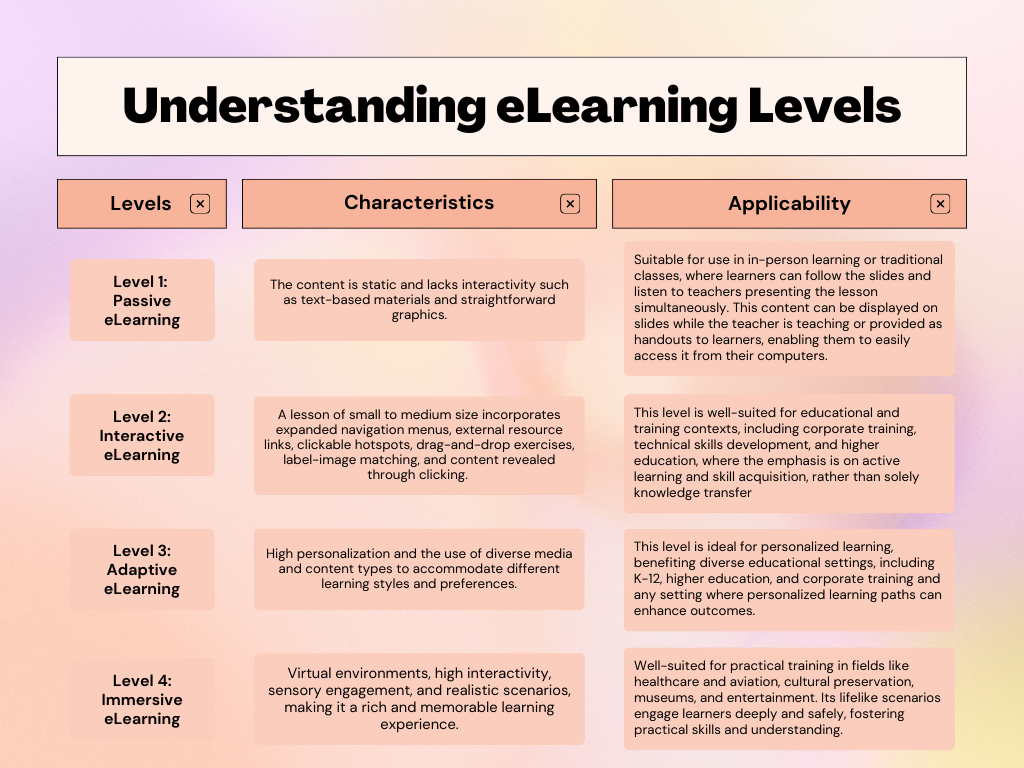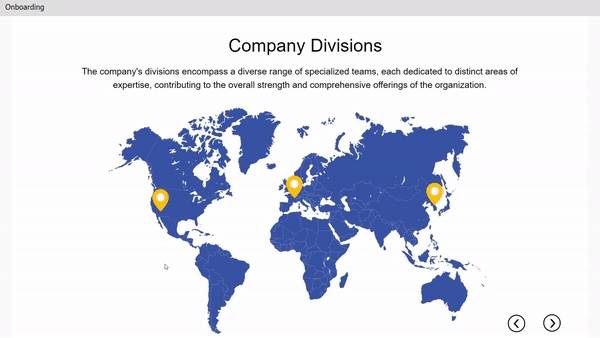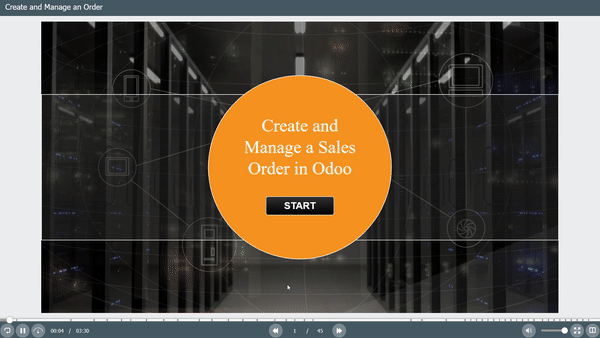Join us in this blog as we’re on a journey to unravel the secrets of eLearning levels. So, you can create a learning experience that totally meets the unique needs of your students.

Introduction to eLearning Levels
In today’s fast-paced digital world, eLearning has emerged as a transformative force in education and professional development. As the availability and accessibility of online learning resources continue to expand, so do the levels of eLearning. These levels range from basic to advanced. And they offer educators and trainers many options to customize their content to suit their learners. The key to successful eLearning lies in understanding these levels and choosing the perfect fit for your learners. So, let’s dive in and explore the world of eLearning levels, unlocking its potential for all those who are eager to learn and grow.

Four Levels of eLearning and Their Characteristics
eLearning can be categorized into four distinct levels, each varying in interactivity, spanning from fundamental to advanced levels. Without further ado, let’s explore a handy comparison table to help you gain a comprehensive understanding.

#1. Passive eLearning
At the foundational level of eLearning, we find Passive eLearning. This level features simplicity and lacks active engagement. In addition, learners only interact by navigating forward or backward through the presented content. That’s why it is often referred to as the click-next or page-turner level. In-person learning, where learners can follow the slides and listen to the teacher presenting the lesson simultaneously, is where this eLearning level suits best.

While passive eLearning is an excellent starting point for those new to a subject, it may not be suitable for individuals seeking a more engaging and participatory educational experience. In the realm of online education, the passive level acts as a stepping stone for learners to explore more interactive and advanced eLearning levels.
💡 Interactivity level: Almost none-interactive. Learners only navigate forward or backward to read or watch the information presented to them.
#2. Interactive eLearning
The second level of eLearning, often referred to as Interactive eLearning. This level introduces a new dimension of engagement and active participation in the learning process. Unlike the passive level, this stage encourages learners to interact with the content, their peers, and instructors. It’s all about fostering a dynamic learning experience where students don’t just absorb information but put it into practice. Interactive eLearning is perfect for scenarios where learners need to collaborate, engage in discussions, problem-solve, and apply their knowledge. It’s particularly useful for developing practical skills and deepening understanding through hands-on exercises.

💡 Interactivity level: At this level, interaction is somewhat restricted, yet it offers users more than simple button clicking. This form of content interactivity provides learners with a certain level of control.
#3: Adaptive eLearning
The third level of eLearning is often referred to as Adaptive eLearning. This level opens the door to a dynamic and highly individualized learning experience. At this level, the learning environment takes on a distinct character, constantly adapting to the specific needs, skills, and progress of each learner. It’s a realm of education where data and analytics play a pivotal role in guiding the learning journey. Therefore, with its real-time adjustments and multi-modal approach, Adaptive eLearning revolutionizes how we approach education.

💡 Interactivity level: A high level of interactivity. Learners actively engage with the content, and the system responds in real-time to their actions and choices, adjusting the learning path accordingly.
#4: Immersive eLearning
Last but not least, level 4 of eLearning, known as Immersive eLearning. It opens the door to a realm of education that goes beyond traditional methods. This level leverages virtual environments. For example, it uses technologies such as augmented reality (AR), virtual reality (VR), or 3D simulations to create lifelike learning spaces. It offers a high degree of interactivity, allowing learners to engage with content and environments, make choices, and experience real-world scenarios. Learners encounter real-life scenarios, challenges, and problem-solving exercises, enabling them to apply their knowledge in practical situations.

💡 Interactivity level: A very high level of interactivity. Learners are actively involved in the learning process, making choices and experiencing content in a highly engaging manner.
Discover the Perfect eLearning Authoring Tool for Your Course Creation Needs: ActivePresenter
In our exploration of Understanding eLearning Levels: Finding the Perfect Fit for Your Learners, we have covered four levels of eLearning and their respective educational approaches. Hopefully, this information will assist you in determining the most suitable level of eLearning for creating the best-fit courses for your learners. An essential aspect of this journey is finding the right tool that allows you to create courses spanning various levels of complexity. That’s where ActivePresenter, an exceptional eLearning authoring tool, steps in.

ActivePresenter, a versatile eLearning authoring tool, is your gateway to crafting a wide range of courses, from the fundamental to the most advanced levels. Whether you’re a beginner looking to build a solid foundation or an advanced user seeking to push the boundaries of digital education, ActivePresenter has the tools and features to help you create tailored courses that captivate your learners.
See Also:
4 Common Blended Learning Models
What is an Authoring Tool? Definitions, Features, and Examples
Tables of Contents
Follow us: